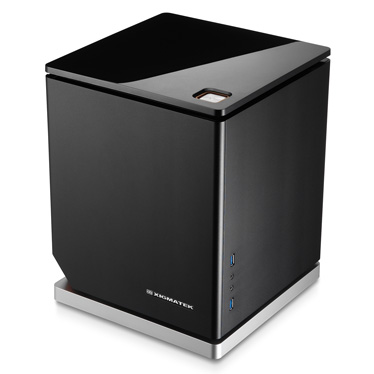Index
We ran our tests on a system supplied by AMD, which came in the form of a lovely black cube, courtesy of Xigmatek. However, don’t let looks fool you. The small Xigmatek Nebula cube contains quite a few quality components, which you might not expect in small_PC rig, so let’s take a look at the building blocks of AMD’s sample.
The A8-7600 APU sits atop a Asrock FM2A88X-ITX+ motherboard. The FM2A88X-ITX+ board is feature packed, with two USB 3.0 ports and two USB 3.0 headers, two PC-19200U DDR3 memory slots, WiFi and Bluetooth 4.0, HDMI 1.4 and 802.11a/b/g/n/ac WiFi. That’s pretty impressive for a mini-ITX board.
AMD decided to use 16GB of Radeon DDR3 memory (2133MHz), a Samsung 840 Pro 256GB SSD, Antec High Current Pro 750W PSU and last but not least, a low profile Noctua CPU cooler. The chassis can accommodate a much bigger cooler though.
Right off the bat we have to point out that some of the components are overkill. You won’t find many mid-range systems with 16GB of 2133MHz memory, a speedy 256GB SSD or a quality 750W PSU. However, if you’re planning to build a Kaveri rig on a tight budget, don’t worry. We ran a few tests with just 8GB of memory, which proved more than enough in most situations. There’s a huge choice of cheap 120-128GB SSDs, too, not to mention cheaper, less powerful PSUs.
You can cut quite a few corners and save a lot of cash without compromising performance, which is good news considering AMD’s decision to position the A8-7600 opposite Intel’s Core i3-4330 (Haswell). The tradeoff will be worth it for most users, as the performance penalty will be negligible.
We included a number of benchmark figures with 8GB of RAM and we also tried to play around with the GPU, allocating 1GB and 2GB of RAM for the frame buffer. BIOS automatically allocates 1GB of memory to the on-die Radeon R7, which is sufficient. However, in case you really need 2GB, you can allocate it, although most users shouldn’t bother.
We compared the performance of the 14.6 driver with the driver supplied to us during initial review back in January. In the graphs the newer driver is explicitely denoted after the APU designation.
